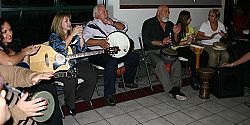Saint Jude Maronite Parish Lebanese Festival boasts traditional food, dance and music
Friday, Oct. 10, 2014

Intermountain Catholic
+ Enlarge
The Anton family plays for the dabke dancing at the Lebanese Festival. IC photo/Christine Young
SALT LAKE CITY — About 300 parishioners and guests enjoyed the spirit and festivities of traditional Lebanese food, dancing and music at the Saint Jude Maronite Parish Lebanese Festival Oct. 4, held at Saint Vincent de Paul Parish in Salt Lake City.
“It’s amazing that such a small parish can make a festival like this happen,” said Claudio Covacci, St. Jude Parish sub-deacon. “Our parish is like a family. And, it’s wonderful to have the support of Bishop John Wester [of Salt Lake City]. He is so supportive of our parish.”
Tammy Anton, a St. Jude parishioner, put together several silent auction baskets as well as prepared some traditional Lebanese desserts prior to the festival. She learned how to make Lebanese dishes and desserts from her mother-in-law, Helen Anton.
“We want to keep all the traditions alive we had growing up,” said Jim Anton, Tammy’s husband.
Helen and John Anton, Jim’s parents, also passed on to their four children the heritage of Lebanese music; how to sing, dance and play traditional songs on several instruments. They always played for the St. Jude Festival, for pleasure with family and friends and later for weddings and the Living Traditions Festival in Salt Lake City. When the siblings married, their spouses became part of the band. Tammy Anton plays the guitar and Jim Anton plays several guitars, the mandolin, the oud and the drums.
“My mother had a beautiful voice and she taught me how to play the drums,” said Jim Anton. “Before they had drums, they made do with what they had; her mom taught her to play the drums using the back of a pan. That was how my grandmother learned as well.”
The songs the Antons play are “the songs my grandparents learned in the late 1800s and taught my parents,” Jim said. “My grandparents immigrated to the United States through Ellis Island between 1904 and 1910. The songs have some Turkish influence. They are folk songs that tell stories; they are very deep and they come from the heart.”
The Anton family band accompanied the traditional Lebanese dabke formation dancing during the festival.
The dances also tell stories such as women going to the well, meeting and conversing, supporting one another in various ways and then getting together and dancing, said Michelle Simon, dabke dance instructor and Anton’s cousin.
“The dabke dance is a line dance primarily in Lebanon, but also in Syria, Palestine, Jordan and Turkey,” said Simon. “They are communal dances done at celebrations such as weddings, anniversaries, birthdays and other occasions.”
The dabke dance originated when an owner of a newly built house added the roof, and people of the village would tamp the roof with their feet in a uniform way to compact it evenly, said Simon. “It was later put to rhythmic songs in an attempt to keep the work fun and useful,” she said.
The dabke is also a collective dance performed in a half circle with a variety of music and steps such as fast steps, hops, jumps, kicks, thumping the floor, and swinging. They are a lot of fun,” Simon said.
Often when Simon was a small girl at a wedding with her family, “the men would all do a dabke,” she said. “I loved seeing them dance. My paternal grandmother, grandfather and relatives would play the traditional Lebanese music and everyone would dance. It was just beautiful because my grandfather would lead and it was like he was the patriarch of the community. Then all the men would do a dance, the women would follow and do a dance and then we would all dance together.”
Today the dabke is danced in clubs, at parties, and at celebrations of all kinds, Simon said.
For questions, comments or to report inaccuracies on the website, please CLICK HERE.
© Copyright 2024 The Diocese of Salt Lake City. All rights reserved.
© Copyright 2024 The Diocese of Salt Lake City. All rights reserved.

Stay Connected With Us